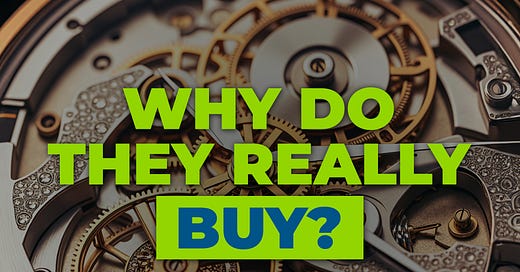Why Customers Really Buy? Find out with the MCF Framework
When companies build their marketing strategy, they often start with a huge assumption: they think they know why customers buy. Unfortunately, that assumption is often partly or entirely wrong. And when you build your strategy on the wrong foundation, everything else becomes shaky.
In this article, I’ll walk you through a powerful method — the MCF framework — to uncover the real reasons behind customer purchases in your category. It’s based on over 25 years of consulting with top brands and it’s designed to turn confusing research into clear strategic focus.
Its not the first, not the last and not the best framework you will ever read. But it provides the most important things to look at – and thru this it can serve as a north star, as a compass in the wild.
The Hidden Danger of Traditional Research
Typical research methods — from qualitative interviews to quantitative surveys, driver analyses, or MaxDiff — often flood you with data. You get dozens of insights, all seemingly important. Yet instead of clarity, what you end up with is more confusion.
I experienced this firsthand as a marketing director for a packaging company. We spent years believing customers cared most about price, quality, or innovation. But after 6 painful years of deep research, I discovered the real driver: customers simply wanted a safe choice. The industrial packaging wasn’t about features; it was about avoiding risk.
And customers wouldn’t tell you this directly — they didn’t even consciously know it themselves. It was hidden, implicit.
That’s why you need better methods to uncover what’s unsaid.
Introducing the MCF Framework
The MCF framework provides a systematic way to find the true reason why customers buy:
1. M = Market View
Most companies analyze why customers buy their brand — but that's not enough. Customers aren’t entirely loyal to your brand; they are loyal to a category need.
You need to research not just your brand but also competitors. Why do customers buy from them? What situations, emotions, needs, and touchpoints drive decisions across the entire category? Within this understanding you then can find your brands place.
Without this broader market view, you can’t accurately identify what motivates purchases — and you won’t know how to steal market share.
2. C = Cause and Effect
Data alone doesn’t tell you what drives what. Correlations and drilling down in data matrixes wont either. You need to model cause and effect relationships.
For example, when researching beer purchases in Germany, tradition and quality were assumed to drive sales. But deeper analysis showed that refreshment was the real driver — not brand heritage.
By understanding these cause-effect links, you can stop wasting time communicating the wrong benefits and instead focus on what truly matters.
3. F = Focus
Finally, once you know the key drivers and how you perform against them, you can create a strategic focus. Use a simple matrix that list the option space of importance of a success driver and your brands performance on this criterion:
High importance, low performance → Fix urgently your performance weakness. When we researched Apple Vision Pro prior launch we found that the intuitive control functionality is the key driver for adoption, but people simply did not believe it will work in practice. A beer brand mentioned about realized that refreshment is the key association but its brand performed relatively poor on it but most competitors did too.
High importance, high performance → Leverage and double down. T-Mobile realized thru Causal AI that a “Robin-Hood” positioning in the market would win customers ( focusing on fairness and fighting for customers, not just on features or pricing gimmicks.). They started double down on the strategy that already was set and introduced on a regular cadence new revolutionary features that had the function to prove its positioning.
Low importance, high performance → Tap on a latent demand. Volvo found they are superiorly positioned to offer a safer car experience. Still customers did only partially used the criterion for brand choices. Volco decided to awake this latent demand and become the leader for customers who are receptive to it.
This focus can transform your strategy. But focus needs to build on the right topic. This requires proper research including Causal AI.
Practical Takeaways
Don't assume you know why customers buy.
Research the full market, not just your brand.
Analyze real cause-effect relationships, not just correlations.
Focus your strategy on what truly drives growth and where you have the chance to win.
Following the MCF framework doesn’t just generate insights — it builds winning strategies.
This is how you 10x Impact.
Download the workbook here






